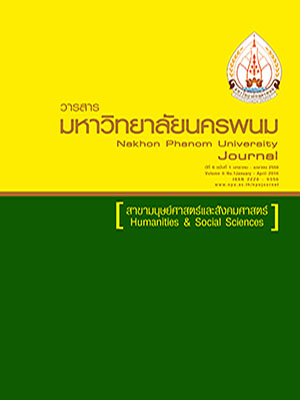การสังเคราะห์รูปแบบสภาพแวดล้อมทางการเรียนเสมือนจริงบนเว็บตามแนวคอนสตรัคติวิสต์ที่ส่งเสริมการคิดอย่างมีวิจารณญาณสำหรับนักศึกษาระดับปริญญาตรี
Main Article Content
Abstract
บทคัดย่อ
การวิจัยในครั้งนี้วัตถุประสงค์เพื่อ 1) การสังเคราะห์รูปแบบสภาพแวดล้อมทางการเรียนเสมือนจริงบนเว็บตามแนวคอนสตรัคติวิสต์ที่ส่งเสริมการคิดอย่างมีวิจารณญาณ 2) การประเมินความเหมาะสมกับรูปแบบสภาพแวดล้อมทางการเรียนเสมือนจริงบนเว็บตามแนวคอนสตรัคติวิสต์ที่ส่งเสริมการคิดอย่างมีวิจารณญาณ เป็นงานวิจัยเชิงคุณภาพ มีรูปแบบการเรียนการสอนแบบสถานการณ์ปัญหา กรณีศึกษา การตั้งคำถามและแผนผังความคิด วิธีดำเนินการวิจัยแบ่งออกเป็น 2 ขั้นตอนได้แก่ 1. การสังเคราะห์รูปแบบฯ ด้วยเทคนิคการสังเคราะห์เอกสาร กลุ่มตัวอย่าง คือ ผู้เชี่ยวชาญด้านสภาพแวดล้อมทางการเรียนเสมือนจริง ด้านการเรียนการสอนบนเว็บ ด้านการเรียนรู้ตามแนวคอนสตรัคติวิสต์ ด้านการคิดอย่างมีวิจารณญาณ รวมทั้งสิ้น จำนวน 9 คน ได้จากการเลือกแบบเจาะจง เก็บข้อมูลโดยใช้แบบสัมภาษณ์นำข้อมูลที่ได้ไปสังเคราะห์เพื่อพัฒนารูปแบบการเรียนการสอน 2. การประเมินความเหมาะสมของรูปแบบการเรียนการสอน กลุ่มตัวอย่าง คือ ผู้เชี่ยวชาญสำหรับประเมินความเหมาะสมของรูปแบบการเรียนการสอน จำนวน 5 คน ได้จากการเลือกแบบเจาะจง การเก็บข้อมูลโดยใช้แบบสอบถาม มาตราส่วนประมาณค่า 5 ระดับ วิเคราะห์ข้อมูลโดยหาค่าเฉลี่ยและส่วนเบี่ยงเบนมาตรฐาน
ผลการวิจัยพบว่า 1) การสังเคราะห์รูปแบบสภาพแวดล้อมทางการเรียนเสมือนจริงบนเว็บตามแนวคอนสตรัคติวิสต์ที่ส่งเสริมการคิดอย่างมีวิจารณญาณมีความเหมาะสมอยู่ในระดับมาก (x = 4.40, S.D. = 0.21) มี 4 องค์ประกอบ คือ 1. องค์ประกอบด้านทฤษฎีและหลักการ 2. องค์ประกอบด้านวัตถุประสงค์ 3. องค์ประกอบด้านการจัดกระบวนการเรียนการสอน 4. องค์ประกอบด้านการประเมินผล 2) รูปแบบสภาพแวดล้อมทางการเรียนเสมือนจริงบนเว็บตามแนวคอนสตรัคติวิสต์ที่ส่งเสริมการคิดอย่างมีวิจารณญาณที่พัฒนาขึ้นมีความเหมาะสมในระดับดี (x = 4.48, S.D. = 0.17) แสดงให้เห็นว่ารูปแบบที่สังเคราะห์ขึ้นสามารถนำไปพัฒนาเป็นเครื่องมือเพื่อใช้ในการเรียนการสอนได้
The purposes of this study were: 1) to synthesize virtual learning environment models on the Web basedon the constructivist theories for promoting critical thinking, 2) to assess appropriateness of the virtual learning environment model on the Web based on the constructivist theories for promoting critical thinking. It was a qualitative research. The instructional model was based on a problem situation, a case study, a problem presentation, and a mind map. The study procedure was divided into 2 steps : 1. synthesizing the models through technique of document synthesis. The sample selected by purposive sampling was experts of virtual learning environment, of instruction on the Web, of learning based on constructivist theories, and of critical thinking, totaling 9 people. An interview guide was used to collect data which then were synthesized for the development of instructional model; 2. assessment of appropriateness of the instructional model. The sample was 5 experts for assessing appropriateness of the instructional model. A 5-rating scale questionnaire was used to collect data. Data analysis was conducted using mean and standard deviation.Findings of the study were as follows : 1) The synthesis of virtual learning environment models on the Web based on the constructivist theories for promoting critical thinking was appropriate at high level (x = 4.40,S.D. = 0.21). The model was composed of 4 elements: 1. theories and principles, 2. objectives, 3. instructional process management, and 4. assessment. 2) The developed virtual learning environment model on the Web basedon the constructivist theories for promoting critical thinking was appropriate at high level (x = 4.48, S.D. = 0.17).It showed that the synthesized model could be developed as a tool to use in learning and teaching.


